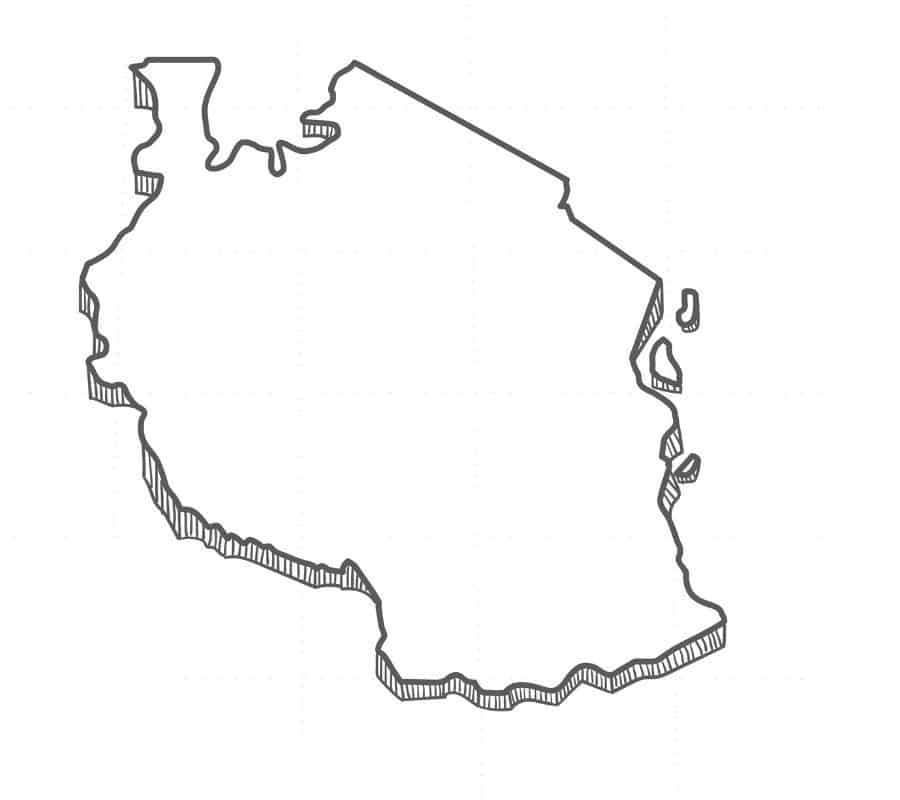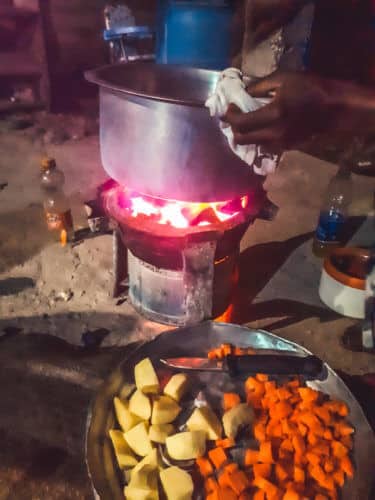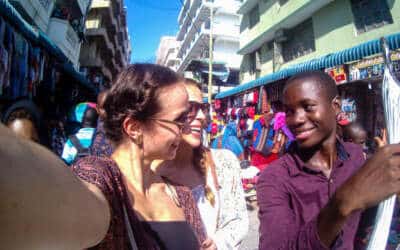Safari, dream beaches and exciting cities

Duration: at least 3 weeks
Best time to visit: October – June
Budget: 65 dollars per day
Tanzania was our first real taste of backpacking in Africa—and honestly, it couldn’t have been a better choice. What struck us most was the mix: one day we were weaving through the chaos of local markets in Arusha, the next we were watching a lioness stalk through the Serengeti, and later that week, we found ourselves on an empty stretch of beach in Zanzibar with nothing but the sound of the waves.
There’s something incredibly raw and real about Tanzania. It’s not just the landscapes—though those are jaw-dropping—it’s the warmth of the people, the stories shared over chai, the Maasai walking alongside highways in full traditional dress, completely unbothered by the modern world rushing past.
For travelers, especially those new to the continent, Tanzania feels like the perfect introduction. It’s welcoming, surprisingly easy to navigate, and full of moments that stay with you long after you’ve left.
- Experience culture 90%
- Beaches 95%
- Nightlife & atmosphere 110%
- Activities 100%
Neither of us had ever been to Africa before and didn’t know what to expect. Tanzania is a country full of surprises. From the moment we arrived in Dar es Salaam, we were mesmerized by the sights and sounds of this vibrant country. Although Tanzania is very well developed for tourism, it is still a wonderful place to get away from the crowds.
Why travel to Tanzania?
Safari in Tanzania
Tanzania has a total of 16 national parks, which are home to a variety of landscapes and animal species.
The best known include the Serengeti National Park, Tarangire National Park, Lake Manyara National Park, the Ngorongoro Crater and Ruaha National Park.
Each national park has its own unique characteristics and offers visitors the opportunity to experience the rich wildlife and breathtaking landscapes.
Tanzania was our first safari destination and we were absolutely thrilled!
Whether you explore one of the legendary hot spots such as the Ngorongoro Crater or the Serengeti National Park, or venture off the beaten track into areas such as Ruaha and Selous, you can be sure that your trip will be filled with unforgettable moments that you won’t soon forget.
And because Tanzania is less well-known than other safari destinations such as Kenya or South Africa, you get better value for money without having to compromise on quality.
Beaches in Tanzania
Tanzania is best known for its nature reserves, but its coastline is just as breathtaking. Whether you’re looking for a backpacker beach with a vibrant party scene or a private island with secluded sandy beaches, there’s something for everyone.
There are countless paradisiacal places on the coast of Tanzania in the Indian Ocean, from the world-famous Zanzibar to the lesser-known island of Mafia. We also really enjoyed the beaches near Dar es Salaam!
Learn more about the Maasai
Although the jumping Maasai have become the symbol of Tanzania and Kenya for travelers, this population group has long been discriminated against. The approximately 140,000 Maasai living in Tanzania are mainly concentrated in the regions around Arusha, the Serengeti and the Ngorongoro Conservation Area.
With their typical clothing and jewelry, the Maasai are among the best-known African tribes.
Traditionally, the Maasai are a nomadic people who live according to the rainy and dry seasons. Nowadays, the people are in a state of upheaval. While increasing attention is being paid to the preservation of culture, natural, environmental and social factors pose an enormous challenge for the people.
We were lucky enough to spend time with the Maasai people during a trip to Tanzania. For us, it was undoubtedly the highlight of our trip.
Not only were we deeply impressed by the landscapes and wildlife in the Ngorongoro Conservation Area and around Lake Natron. After a few nights spent under cow hides in the open air and listening to stories about the life of the Masai, we were deeply grounded and overwhelmed.

Mount Kilimanjaro
Kilimanjaro is not only one of the highest and most impressive mountains in the world, but also a popular climbing destination.
With its towering peak, which is over 5,895 meters above sea level, Kilimanjaro is a destination for climbers from all over the world.
It was first climbed in 1889 by the German geologist Hans Meyer, the Austrian mountaineer Ludwig Purtscheller and the local guide Yohani Kinyala Lauwo.
Today, an estimated 30,000 people make the arduous journey up Kilimanjaro every year.
Despite its popularity within the country and its easy accessibility, Kilimanjaro is not always easy to conquer.
It is reported that up to 50% of climbers fail in their attempt to reach Uhuru Point, the summit of the mountain.
However, those who reach the summit are rewarded with an incredible sense of achievement and a breathtaking view of the Tanzanian landscape from the top.
Festivals and events
Sauti za Busara Music Festival
This festival takes place annually in Stone Town, Zanzibar, and celebrates African music and culture with live performances by local and international artists.
Zanzibar International Film Festival
One of the biggest events is the Zanzibar International Film Festival (ZIFF), which takes place annually in Stone Town, Zanzibar. The ZIFF celebrates African cinema with film screenings, workshops and cultural performances and attracts filmmakers and interested parties from all over the world.
Kilimanjaro Marathon
The Kilimanjaro Marathon attracts runners from all over the world to compete against the breathtaking backdrop of Mount Kilimanjaro.
Nane Nane Agricultural Fair
The annual Arusha Agricultural Fair, held on August 8, is an important event in Tanzania, celebrating the country’s agriculture with exhibitions, demonstrations and competitions.
Eid al-Fitr and Eid al-Adha
These religious festivals mark the end of Ramadan or the annual Hajj pilgrimage and are celebrated throughout the country with feasts, prayers and feasting, especially in Muslim-majority regions such as Zanzibar.
Tanzania’s food culture
Tanzanian food culture is a tasty mixture of local traditions and influences from Arabic, Indian and European cuisine. Basic ingredients such as corn, rice and beans form the basis of many dishes, such as ugali, a thick corn porridge that is often served with meat or vegetables. In the coastal regions, coconut milk is a common ingredient that enriches dishes such as pilau rice and coconut fish curry. Street food is very popular, with vendors selling snacks such as mandazi (fried dough) and mishkaki (grilled meat skewers). Swahili cuisine, which is widespread on the coast, offers dishes such as biryani, a fragrant rice dish with spices and meat or seafood. Fish and seafood are plentiful, with freshly caught dishes such as grilled octopus and fried tilapia being very popular.
Highly recommended for gourmets:
Highly recommended for gourmets:
- The weekly food market in the Foodhari Gardens in Stone Town
- Street food in Dar es Salaam
Practical travel tips for Tanzania
What language is spoken in Tanzania?
Several languages are spoken in Tanzania, as the country is home to a large number of ethnic groups.
The official language is Swahili, while English is widely spoken as a second official language and is used in schools and government affairs.
In addition, various Bantu languages such as Chagga, Sukuma and Haya as well as languages of the Nilosahara and Khoisan language families are spoken, depending on regional ethnicity.
What is the best time to travel to Tanzania?
The best time to travel to Tanzania depends on individual preferences and the activities planned.
In general, the dry season from June to October is ideal for safaris as the weather is pleasantly cool and game viewing is easier due to the lower foliage. This period also coincides with the great animal migration in the Serengeti, a spectacular natural spectacle.
The dry season from June to October is also suitable for beach vacations and diving activities, as the temperatures are warm and the weather is usually sunny.
The short rainy season from November to December can also be a good time to visit, as the landscape is green and lush and there are fewer tourists.
However, it is important to note that some remote safari lodges may be more difficult to reach during the rainy season.
Is Tanzania safe?
Tanzania is a safe country to travel to, including Dar es Salaam. However, we have heard that you should watch out for pickpockets. We were warned not to visit the Kariakoo market, but we cannot confirm the warnings. However, you shouldn't wander around too long after dark and take a cab.
What is the currency in Tanzania?
Public transportation in Tanzania
Local public transport in Tanzania is mainly operated by daladalas - private minibuses.
These minibuses are often very full, but they are also the most efficient way to get around. They may take some getting used to, but you'll get to know a lot of people!
There are also micro-transits, but the Daladals are the best option for getting around Tanzania. Plus, transportation is the best way to save money for your next safari! Other routes are undertaken with older coaches.
Internet and sim cards in Tanzania
The largest provider in Tanzania is Vodacom, which has the best coverage in the country.
However, it is also the most expensive provider. The easiest way to buy a SIM card in Tanzania is directly in front of the international terminal at Dar es Salaam airport.
When you leave the arrivals area, you'll be standing right in front of a Vodacom store, and it only takes five minutes to get a SIM card.
Can I drink the tap water in Tanzania?
No! Make sure you take a water filter or a self-cleaning UV water bottle with you!
What should I look out for on my trip?
Waste: As everywhere in Latin America, most street food is served in plastic or disposable containers. Be sure to take your foldable food container with you. Don't forget to take your Lifestraw with you.
Sun protection: Protect the coast of El Salvador by using reef-compatible sunscreen.
Packing list Tanzania
Planning a trip to Tanzania is exciting—but knowing what to pack can be tricky. From the dusty plains of the Serengeti to the breezy beaches of Zanzibar, Tanzania’s landscapes, limates and cultures are wildly diverse.
Whether you’re heading out on safari, climbing Kilimanjaro, or exploring local markets in Arusha, packing smart will make all the difference.
After traveling through Tanzania multiple times—from luxury lodges to tented camps and everything in between—I’ve fine-tuned this practical, no-fluff packing list to help you stay comfortable, respectful, and ready for every adventure that comes your way.
Our Tanzania itinerary
Diving in Zanzibar
Duration: at least ten days Where to Stay: Sunshine Marine Lodge or Sunshine Azure It only took one backwards roll off a wooden dhow in Matemwe for me to fall—quite literally—head over fins for Zanzibar’s reefs. I’d signed up with Dive Point Zanzibar to earn my...
Two weeks Tanzania itinerary
I’ve returned to Tanzania time and again, and this two-week itinerary brings together my favorite moments — lively markets in Dar es Salaam, game drives in Ngorongoro and the Serengeti, and lazy days on the beaches of Zanzibar or Mafia Island
Tarangire National Park
Planning a Tanzania safari? Here’s my firsthand guide to Tarangire National Park—how to get there, when to visit, where to stay, and what to pack for the ultimate elephant‑filled adventure
Diving Zanzibar
Diving in Zanzibar unlocks warm Indian-Ocean reefs brimming with turtles, reef sharks and seasonal whale-sharks—from Mnemba’s “aquarium” walls to Pemba’s drop-offs. Get my first-hand tips on the best dive sites, seasons, marine life and eco-friendly practices after earning my Open Water with **Dive Point Zanzibar**.
Zanzibar | Discover the most beautiful beaches
The beaches in Zanzibar are stunning. White palm trees seam white sandy beaches with perfectly turquoise water. Even though Zanzibar has been a popular tourist destination for quite some time, you’ll still find authentic, quiet villages and empty beaches.
Safari | A once in a lifetime wildlife experience
Are you planning a safari in Tanzania? Tanzania’s Northern Circuit is a great place to start. This region offers several stunning national parks, including Tarangire, Lake Manyara, Ngorongoro Crater, and the famous Serengeti. Tour operators provide many possibilities, ranging from budget camping safaris to luxury lodging safaris.
Arusha | City life & safari adventures
Arusha, Tanzania, is a city in the middle of two worlds. This creates an exciting mix of people and cultures that make Arusha is unique. Arusha itself is a dusty, charming mid-sized African city.
Dar es Salaam | Karibu to a vibrant Tanzanian city
Tanzania’s former capital, often referred to as “Dar,” is not only Tanzania’s second largest city but one of the fastest growing cities in the world. Located along the coast of the Indian Ocean, Dar es Salaam is brimming with activities for anyone.
Stone Town | Melting pot of cultures & foodie haven
There are so many exciting things to don in Stone Town, Zanzibar’s mutli layered capital. We quickly lost ourselves wandering the narrow streets of Zanzibar’s cultural heart: Stone Town. It almost feels like a journey in time as we pass decayed buildings. Stone Town is sheer incredible, and we promise you, that you’ll be mesmerized at every corner!
Lake Natron | Maasailand & surreal landscapes
We had heard of Lake Natron before our arrival to Tanzania and of course the pictures of the bright red lake we stumbled upon during our online research sparked our interest. But, we thought to visit Lake Natron was off limits due to our time and budget restrictions. Quite unexpectedly we found ourselves on one of the most mesmerizing journeys through Maasailand!

















